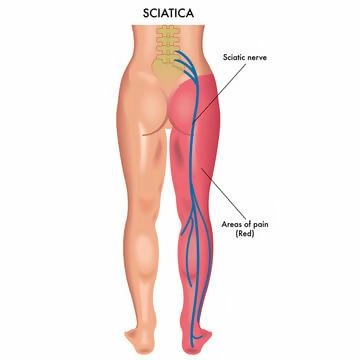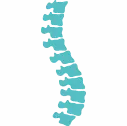The most important component of a successful sciatica treatment plan is proper diagnosis and treatment of the cause of sciatica along with a simultaneous comprehensive pain relief program.
Dr. Scott can diagnose the cause of your sciatica by providing a thorough physical examination of the lumbar spine, hip, and knees, including muscles, joints, posture, and gait, as well as discuss past injuries and lifestyle habits that may be contributing to your condition. Biomechanical, neuromuscular, range of motion and functional tests are conducted to determine the cause. Other tests such as MRI, EMG, X-rays, blood tests or nerve conduction velocity testing may be performed. At The Total Health Center, we have specialty training in complex joint and soft tissue problems that cause sciatica so our patients can have confidence that their doctor is providing thorough chiropractic care for sciatic pain relief.
Do not ignore sciatica symptoms. Although relatively uncommon, prolonged compression of the cord levels feeding into the sciatic nerve and the sciatic nerve itself can lead to permanent nerve damage. See a doctor for a proper diagnosis. In our office, we provide immediate exams for sciatica pain. Just let us know that you are in pain, and we will accommodate you with an immediate, same-day exam. It is also important to be aware that sciatica symptoms differ from progressive leg weakness and any loss of or changes in bladder or bowel function. If either of these particular symptoms arises, this is an emergency. Call 911 and seek care from your nearest hospital emergency room.
What Is Sciatica?
Did you know that sciatica is not an injury or disease? That may surprise you if you have been told by a healthcare specialist that you have sciatica after complaining of pain. Instead, sciatica is a symptom described as neuropathic (nerve pathology) or radicular (radiating) pain felt due to irritation of the “sciatic nerve,” or a component of it.

Although the sciatic nerve officially originates at the pelvis and travels downward, there are five spinal cord segments (L4 through S3) that feed into the beginnings of the sciatic nerve. Your sciatic nerve is an impressively massive nerve bundle that runs either over, through, or under your piriformis muscle, depending on your individual anatomic variation, and ends about an inch above the knee where it branches off.
The spinal cord nerve roots that originated from the L4, L5, S1 and S2 go on to form the common peroneal nerve right above your knee and travel down the side of your leg to your foot. The spinal cord roots that originated from the L4, L5, S1, S2 and S3 go on to form the tibial nerve right above your knee and also continue down the back of your leg to your foot.
Sciatica Symptoms
Because 10-15% of sciatica patients experience a recurrence of sciatic pain, it is important to uncover and treat the underlying cause, ensure proper muscle coordination, strengthen core and surrounding muscles, and maintain flexibility and joint mobility with regular activity and chiropractic maintenance evaluations and treatments as needed.
What Does Sciatica Feel Like?
In general, medical professionals define sciatica as numbness, weakness, burning, tingling or even a sharp pain on one side of the body, in the area of the lower back, buttocks, hip, leg, or foot. Pain may radiate down the leg just a little bit or the entire way down to the foot. Pain is usually worse when bending over or rotating the trunk.
Radicular or radiating pain is one of the more frequent and intense symptoms associated with sciatica that we see in our office. You may also feel numbness and tingling or a pins-and-needles feeling that may occur in your lower back and travel all the way down your leg. You may feel this sensation in any area of your lower body, just as you may feel shooting pain travel down your leg that originates in your lower back. Depending on the amount of cord level compression you may experience weakness or what is called foot drop (when you can’t dorsiflex or lift your foot up properly) – this occurs with a disc injury.
All of these symptoms can range from very mild to severe and debilitating. The symptoms may occur gradually or suddenly and may be constant, or they may be transient. Pain occurrence may also depend on your activity or inactivity. If a disc herniation is the cause of your sciatica symptoms, you may notice exacerbated shooting pain when you cough or sneeze. Once sciatica symptoms are noticeable, the nerve circulation has been affected to the point where motor axons are misfiring upon their death and causing pain signals (nociceptive signals) to go haywire. If the axons are dying, then the affected muscles will also experience pain, twitching, and atrophy.

A study published in the Journal of Manipulative and Physiological Therapeutics found that chiropractic care has a “long-term outcome advantage” over standard medical attention for patients with some types of sciatica. The study noted that “The chiropractic encounter may have enhanced patients’ self-efficacy motivation, leading to better coping abilities and better pain and disability outcomes.” (J Manipulative Phys. Ther. 2001; 24:543-51)
https://www.rennwellness.com/sciatica.html
Call 757-363-8571 to schedule your sciatica treatment consultation with Dr. Mark Scott at Total Health Center Virginia Beach today! We look forward to helping you feel better.

